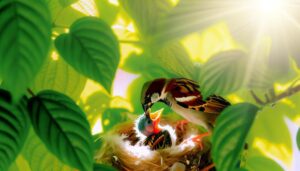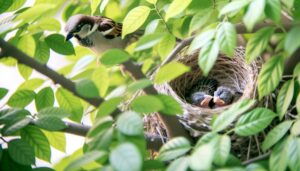Another Name for Baby Sparrow: Terminology Explained
You call a baby sparrow a ‘nestling‘ while it’s in the nest and entirely dependent on its parents for food and care. As it grows and starts learning to fly, it’s referred to as a ‘fledgling.’ This term comes from Old English and denotes a young bird that has developed feathers necessary for flight.
Understanding these terms is vital for proper care and accurate identification, which is particularly important for wildlife rehabilitation and birdwatching. You’ll discover even more fascinating details about their developmental stages and habitat needs if you continue exploring.

Key Takeaways
- A baby sparrow in the nest is scientifically called a nestling.
- When transitioning to flying, a baby sparrow is known as a fledgling.
- The term “chick” can also refer to a baby sparrow.
- “Hatchling” refers to a baby sparrow that has just emerged from the egg.
- “Juvenile” describes a young sparrow that is more developed than a fledgling.
What Is a Baby Sparrow Called?

A baby sparrow is scientifically referred to as a nestling while it remains in the nest, and later as a fledgling when it begins to fly. As a nestling, the baby sparrow is entirely dependent on its parents for food and protection. You’ll notice the nestling has closed eyes and sparse feathers, making it vulnerable and reliant.
During this stage, accurate care and feeding are essential for its development. Understanding these terms helps you provide better care by recognizing the different needs of the sparrow at each stage. If you’re involved in wildlife rehabilitation or birdwatching, knowing the distinction ensures you can offer the appropriate support at the right time. Your role could significantly influence their survival and growth.
The Term ‘Fledgling’
Recognizing the term ‘fledgling‘ is crucial as it refers to a young sparrow that has developed enough feathers and strength to leave the nest but still relies on its parents for feeding and protection.
You’ll see these fledglings hopping around, testing their wings, and gradually improving their flying skills. They’re at a critical developmental stage, balancing independence with parental support. Understanding this term helps you better identify their needs and behaviors.
If you find a fledgling, remember it’s normal for them to be on the ground. Their parents are usually nearby, continuing to care for them. Your awareness can guarantee you provide appropriate assistance, fostering their safe progression to full independence.
Historical Origins of ‘Fledgling’

Understanding the current developmental stage of a fledgling is essential, and tracing the historical origins of the term ‘fledgling’ provides deeper insights into its etymology and usage in ornithology.
The word ‘fledgling’ derives from the Old English ‘fledge,’ meaning to acquire feathers. This transformation from a featherless chick to a feathered juvenile ready to leave the nest is pivotal in bird development. By the 19th century, ‘fledgling’ was widely adopted in scientific literature.
| Term | Origin |
|---|---|
| Fledge | Old English |
| Fledgling | 19th Century |
| Etymology | Study of Word Origins |
| Ornithology | Study of Birds |
| Juvenile | Young Bird |
Understanding these origins helps you appreciate the precise language used to describe avian growth stages.
Differences Between Chicks and Fledglings
You’ll notice that chicks and fledglings are at different physical development stages, with chicks being younger and mostly featherless, while fledglings have more developed plumage.
Chicks rely heavily on parental feeding, whereas fledglings start to show some independence, though they still need occasional help.
Understanding these distinctions helps in identifying and caring for young sparrows accurately.
Physical Development Stages
While both chicks and fledglings are young sparrows, they exhibit distinct physical differences that mark their respective stages of development.
You’ll find that chicks are typically characterized by their closed eyes, sparse downy feathers, and reliance on the nest for warmth and protection.
In contrast, fledglings have more developed feathers, open eyes, and are beginning to explore their surroundings.
Here are three key differences to note:
- Feather Development: Chicks have downy feathers, while fledglings have more structured, juvenile feathers.
- Mobility: Chicks remain in the nest, whereas fledglings start to hop and flutter nearby.
- Eye Condition: Chicks have closed or partially open eyes; fledglings have fully open, alert eyes.
These distinctions help you understand their growth and needs better.
Feeding and Independence
As chicks depend entirely on parent sparrows for food, fledglings begin to show signs of feeding independence by practicing self-feeding and accepting less frequent parental feedings. During this important phase, you’ll notice fledglings pecking at seeds and insects, mimicking adult behavior. Their beaks start to harden, enabling them to crush food more effectively. Parent sparrows will reduce feedings, encouraging fledglings to forage.
You’ll also see fledglings hopping and fluttering, building muscle strength and coordination. This period is vital for developing survival skills. As their confidence grows, fledglings spend more time away from the nest, exploring their environment.
Sparrow Life Stages
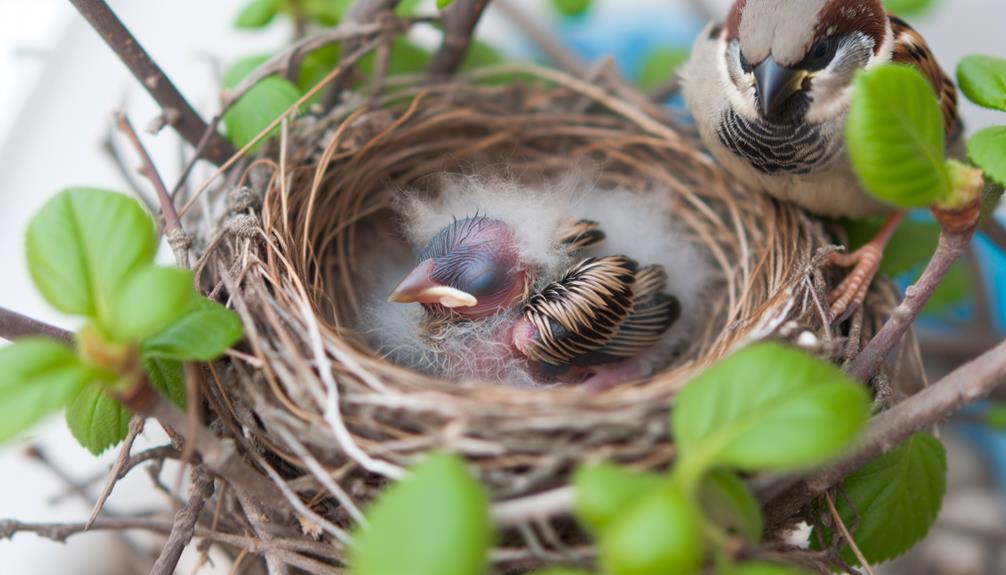
A sparrow’s life stages can be distinctly categorized into the egg, nestling, fledgling, juvenile, and adult phases, each with unique developmental milestones and characteristics. Understanding these stages helps you better care for these birds at every point in their lives.
- Egg Phase: Lasting about 10-14 days, this phase involves incubation, primarily by the female.
- Nestling Phase: Spanning 10-12 days post-hatching, nestlings are entirely dependent on parental care for food and warmth.
- Fledgling Phase: At around 14-17 days old, fledglings leave the nest but still rely on parents for feeding and protection until they can forage independently.
Comprehending these important stages ensures you can provide adequate support and intervention when necessary.
Common Sparrow Species
When considering common sparrow species, you’ll often encounter the House Sparrow and the American Tree Sparrow. The House Sparrow is known for its adaptability to urban environments and distinctive black bib.
In contrast, the American Tree Sparrow thrives in open woodlands and is recognizable by its rusty cap and bi-colored bill.
House Sparrow Traits
House sparrows, known scientifically as Passer domesticus, display distinct traits such as their stout bodies, short tails, and conical bills. You’ll notice their plumage varies between sexes; males exhibit bold black bibs, while females and juveniles have more subdued coloring. These birds are highly adaptable and thrive in urban environments.
To better understand their unique characteristics, consider the following:
- Diet: Primarily granivorous, but they’ll also consume insects, especially during breeding season.
- Nesting: They nest in cavities, often utilizing man-made structures like eaves and birdhouses.
- Social Behavior: Highly social, they form large flocks and engage in communal roosting.
American Tree Sparrow
Among the various common sparrow species, the American Tree Sparrow, known scientifically as Spizelloides arborea, stands out with its distinctive rusty cap and bi-colored bill. You’ll find these birds primarily in North America, especially during the winter months. They prefer open habitats such as fields and marshes, making them relatively easy to spot.
Here’s a quick overview of their key characteristics:
| Characteristic | Description |
|---|---|
| Scientific Name | Spizelloides arborea |
| Distinctive Feature | Rusty cap and bi-colored bill |
| Habitat | Fields, marshes, and open areas |
| Winter Range | Across North America |
| Diet | Seeds and small insects |
Knowing these details, you can help others identify and appreciate the American Tree Sparrow in your community.
Habitats of Sparrows
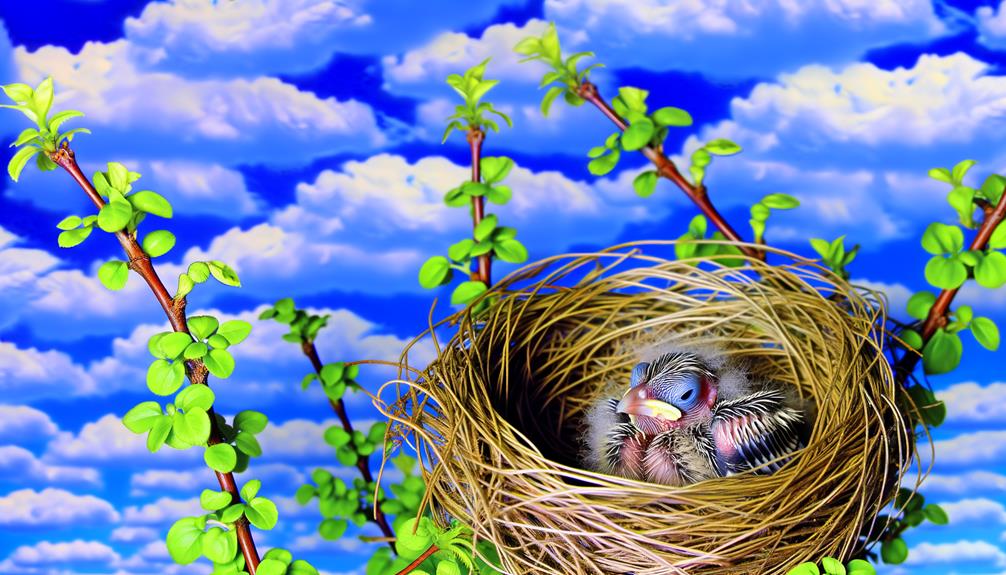
Sparrows thrive in diverse habitats ranging from urban environments to grasslands, showcasing their remarkable adaptability to different ecological niches. You’ll find them in:
- Urban Areas: Sparrows often nest in buildings, parks, and gardens, benefiting from human activity.
- Agricultural Fields: These birds exploit crop fields for food and nesting, making them common in rural landscapes.
- Grasslands: Natural grasslands offer abundant seeds and insects, essential for their diet and breeding.
Understanding these habitats helps you support sparrow populations effectively. Urban planners can incorporate green spaces, farmers can implement bird-friendly practices, and conservationists can protect natural grasslands. By knowing where sparrows thrive, you can contribute to their survival and the ecological balance they help maintain.
Feeding Baby Sparrows
When feeding baby sparrows, you need to establish an appropriate feeding schedule that aligns with their rapid growth.
You’ll also want to guarantee their diet meets specific nutritional needs, focusing on high-protein sources.
Appropriate Feeding Schedule
To ascertain a baby sparrow’s healthy growth, you should feed it every 20 to 30 minutes from dawn until dusk. This frequent feeding schedule mimics the natural feeding pattern and ensures the bird receives adequate nutrition. Each feeding session should be brief but thorough, making certain the chick swallows and digests the food effectively.
Make sure to adhere to the following guidelines:
- Consistency: Maintain a strict feeding schedule to prevent malnutrition and promote steady growth.
- Observation: Monitor the chick’s behavior and adjust the amount of food based on its hunger cues.
- Hygiene: Use clean utensils to avoid infections and maintain a sanitary feeding environment.
Nutritional Needs Explained
Understanding the nutritional needs of baby sparrows is vital for their survival and development, requiring a diet rich in proteins and fats to support their rapid growth. You should provide a balanced diet that mimics what they would get in the wild. Insects, like mealworms, are excellent protein sources. High-fat foods, such as finely chopped nuts, are also beneficial. Avoid bread and milk, as these can harm their digestive systems. Hydration is essential, but water should be offered carefully to prevent choking.
| Nutrient | Source | Importance |
|---|---|---|
| Protein | Insects (mealworms) | Muscle and tissue growth |
| Fats | Chopped nuts | Energy and insulation |
| Vitamins | Fresh fruits | Immune system support |
| Minerals | Eggshell powder | Bone development |
| Hydration | Clean water | Overall bodily function |
Sparrow Nesting Habits
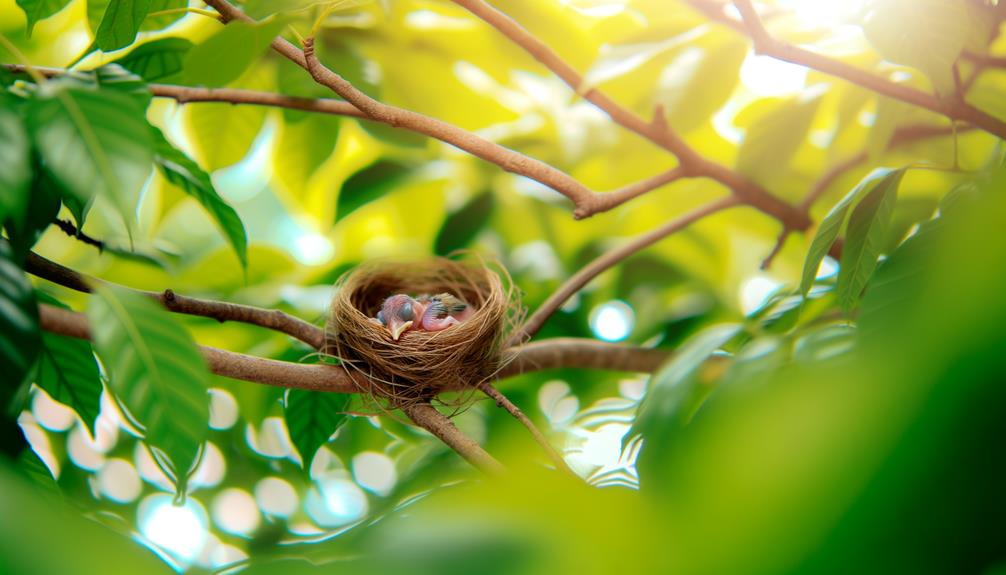
Sparrows exhibit intricate nesting habits, often constructing their nests in sheltered locations like tree cavities, eaves of buildings, or dense shrubbery. These birds are meticulous in their choice of nesting sites, ensuring that their offspring are well-protected from predators and harsh weather conditions.
You’ll find that sparrows use a variety of materials to build their nests, including twigs, grasses, and feathers.
To support sparrow nesting efforts, consider:
- Providing Nesting Materials: Offer twigs, grasses, and feathers in your garden.
- Setting Up Nesting Boxes: Install nesting boxes in safe and sheltered areas to encourage sparrows to settle.
- Maintaining a Safe Environment: Keep the area around the nests free from potential threats like predators and disturbances.
Protecting Young Sparrows
Guaranteeing the safety of young sparrows necessitates diligent monitoring of their nesting sites to deter predators and mitigate environmental dangers.
You should set up predator guards around nests to ward off cats, snakes, and other threats.
Regularly inspect for signs of infestation by mites or other parasites, and utilize appropriate treatments if necessary.
Keep nesting areas tidy by removing debris and old nests to prevent disease.
Additionally, provide a dependable food source, such as seed feeders, to support the parents and their chicks.
Ensure water sources are clean and accessible.
Conclusion
You’ve now navigated the nuanced narrative of baby sparrows, from fledglings to their fascinating feeding habits. Sparrows’ stages, from chicks to fledglings, are steeped in scientific importance.
By protecting their nests and nourishing their needs, you’re nurturing nature’s next generation. With precise practices, you can safeguard these small songbirds, ensuring they continue to chirp cheerfully in our shared ecosystems.
Your contributions, though seemingly small, are meaningfully shaping the survival of these splendid sparrows.


